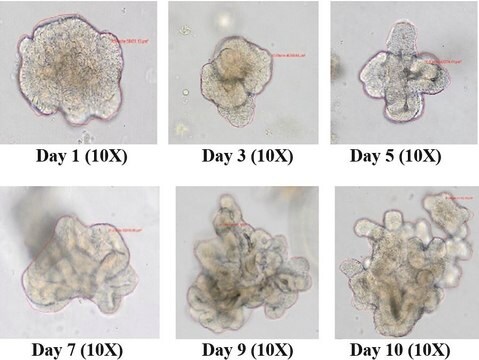SCM301
3dGRO® Organoid Freeze Medium
Optimized cryopreservation media for multiple organoids cell types.
Synonim(y):
Organoid cryopreservation medium
About This Item
Polecane produkty
Postać
liquid
metody
cell culture | stem cell: suitable
Powiązane kategorie
Opis ogólny
• Similar composition and architecture to primary tissue: Organoids harbor small population of self-renewing stem cells (such as intestinal crypt stem cells) that can differentiate into cells of all major cell lineages, with similar frequency as in physiological conditions.
• Relevant models of in-vivo conditions: Organoids are more biologically relevant to any model system and are amenable to manipulate niche components and gene expression.
• Stable system for extended cultivation: Organoids can be cryopreserved as biobanks and expanded indefinitely by leveraging self-renewal and the differentiation capability of the stem cell populations.
Organoids can be cryopreserved using standard cell freezing techniques however freeze/thaw viability remains a challenge. The 3dGRO Organoid Freeze Medium is a proprietary optimized cryopreservation media for multiple organoids cell types (etc. mouse intestinal organoids, human colon and lung organoids). The media supports higher freeze/thaw viabilities compared to other commercial or homemade organoid freezing media formulations.
Zastosowanie
Cell Culture
Stem Cell Research
Jakość
Osmolality: 250-350 mOsm
pH: 6.8-7.1
Sterility Tested: No Growth/Pass
Bacterial & Fungal Tested: Passed
Przechowywanie i stabilność
Informacje prawne
Oświadczenie o zrzeczeniu się odpowiedzialności
Kod klasy składowania
12 - Non Combustible Liquids
Klasa zagrożenia wodnego (WGK)
WGK 3
Temperatura zapłonu (°F)
Not applicable
Temperatura zapłonu (°C)
Not applicable
Certyfikaty analizy (CoA)
Poszukaj Certyfikaty analizy (CoA), wpisując numer partii/serii produktów. Numery serii i partii można znaleźć na etykiecie produktu po słowach „seria” lub „partia”.
Masz już ten produkt?
Dokumenty związane z niedawno zakupionymi produktami zostały zamieszczone w Bibliotece dokumentów.
Klienci oglądali również te produkty
Produkty
Human epithelial intestinal colonic organoids can be used as an alternative to Caco-2 drug permeability assays for drug screening and compound toxicity testing.
Lung organoids are valuable 3D models for human lung development and respiratory diseases. The 3dGRO™ differentiation protocol generates organoids from human iPSCs in 4 steps.
Organoidy płuc są cennymi modelami 3D dla rozwoju ludzkich płuc i chorób układu oddechowego. Protokół różnicowania 3dGRO™ generuje organoidy z ludzkich iPSC w 4 krokach.
Organoid culture FAQs. Learn how to culture and analyze organoids following established 3D cell culture protocols. Tips and tricks.
Protokoły
How to stain organoids? A complete step-by-step protocol for immunofluorescent (IF) and immunocytochemical (ICC) staining of organoid cultures using antibodies
Jak wybarwiać organoidy? Kompletny protokół krok po kroku do barwienia immunofluorescencyjnego (IF) i immunocytochemicznego (ICC) hodowli organoidów przy użyciu przeciwciał
A rapid in vitro assay for CFTR function, the forskolin-induced swelling protocol uses human colon organoids, which can be derived from cystic fibrosis patient tissue.
Highly characterized cryopreserved human colonic organoids and a step-by-step organoid culture protocol for epithelial intestinal organoid differentiation from iPS cells.
Nasz zespół naukowców ma doświadczenie we wszystkich obszarach badań, w tym w naukach przyrodniczych, materiałoznawstwie, syntezie chemicznej, chromatografii, analityce i wielu innych dziedzinach.
Skontaktuj się z zespołem ds. pomocy technicznej








